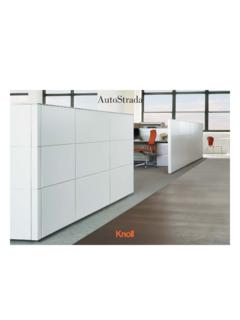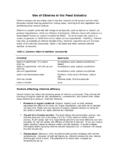Transcription of Five Trends that Are Dramatically Changing Work …
1 Five Trends that Are Dramatically Changing work and the Workplace By Joe Aki Ouye, Co-Founder and PartnerNew Ways of Working, LLCK noll Workplace ResearchFive Trends that Are Dramatically Changing work and the WorkplacePage 1 2 011 knoll , Changing Nature of WorkMy wife, a manager at Hewlett-Packard, usually has a two minute commute a thirty foot walk from the kitchen up to her office. She goes to the central office about once every other week, more to keep in touch socially rather than to formally collaborate. Although she only meets face-to-face with her globally-based team members about once per year, she has an audio conference with them weekly.
2 As HP s work force grows and becomes more global, she is a highly sought after manager. She has learned how to work with her distributed team, setting clear directions, communicating often and clearly, and, most importantly, creating activities to engender team trust and cohesion. Most workers today do not work like my wife; most still commute to and from traditional, centralized offices and work with teams in close proximity. Nevertheless, more and more of us are or will be working in both non-traditional ways and places, ranging from relying on adaptable furniture and hoteling desks at the central office, to satellite offices, offshore offices, and telework from to a recent benchmarking study by our research consortium, The New Ways of Working, many organizations are formalizing Alternative Workplace programs that combine nontraditional work practices, settings and Almost half of the surveyed organizations have started an alternative workplace program within the past two years and a large majority within the past five years.
3 This is striking as these programs have been around since the early The same study indicates that the adoption of such programs has accelerated during the recent Great Recession and shows no sign of letting up. Why, after all these years, is this happening now? Why has the pace of change picked up so Dramatically ? What does it mean for how and where we will work in the future? This paper identifies five Trends that are Dramatically Changing work and workplaces. The first two Trends have been around for more than a quarter of a century: 1. The continuing distribution of organizations 2. The availability of enabling technologies and social collaboration tools Their adoption has pushed alternative ways of working well past the pioneering stage and into the mainstream, when enough organizations have adopted an innovation in order that the continued adoption of the innovation is self-sustaining.
4 3 These two Trends will be reinforced by three more that will induce further change: 3. The coming shortage of knowledge workers 4. The demand for more work flexibility 5. Pressure for more sustainable organizations and workstyles Collectively, these Trends are most pronounced in technology companies, the sector that has historically led the way in adoption of new technologies and workstyles that go with them. However, as technology has become more integral to the operation or mission of organizations, these themes are permeating the larger work community. Importantly, these Trends generally don t impact the workplace directly, but have more to do with affecting how we work .
5 The physical workplace is far more than just furnishings and real estate; it is also about how people work and are managed, the technologies that enable the work , and how the organization employs the workplace for its own ends. Going further, the workplace even reflects forces of the larger social and economic environment. Many organizations are formalizing Alternative Workplace programs that combine nontraditional work practices, settings and locationsFive Trends that Are Dramatically Changing work and the WorkplacePage 2 2 011 knoll , 1: The Continuing Distribution of OrganizationsOrganizations are becoming more spatially and organizationally distributed.
6 Within central offices, work is less concentrated in individual, dedicated workspaces as collaborative activities gain greater significance. More broadly, dispersion is driven by the outsourcing of functions to service providers, the relocation of work to lower cost locations, the push of responsibilities to lower organizational levels, and the ever-present imperative to lower non-direct s no secret that companies are shrinking their own staffs (workers employed directly by the organization). More non-core functions, such as IT, human resources, accounting, purchasing, and corporate real estate, are being outsourced. And remaining functions are continuing to be distributed nationally and globally, primarily driven by lower labor costs in other regions, proximity to internal or external customers, and access to talents and skills not available locally.
7 As a result, organizations increasingly represent a complex web of employees, suppliers, and customers both collocated and dispersed around the world. Organizations are also pushing decision-making wider and lower in the organization. Companies can t just cut costs; they have to continually extend into new markets as well as protect their existing ones. To do this, they have to react quickly to local conditions and not wait for decisions to go up the management chain and then down again. Decisions are often now being made by people closer to customers, housed in smaller satellite offices embedded in the markets they serve. Organizations have discovered that they can cut huge amounts of indirect costs by limiting travel about a $100 mllion annual expense for a $10 billion company and reducing square footage dedicated to the individual worker.
8 They are replacing expensive face-to-face meetings with remote technologies, and combining centralized workplaces with alternative workplace programs. Despite their fears, many managers have found that workers are able to remain productive, thus encouraging further reduction of travel budgets and the conversion of more static, individually-oriented space to collaborative work settings. However, you can t simply transfer existing ways of working management styles, work practices, collaboration technologies and workplaces into newly distributed organizations and be successful. As explained later, you have to adopt new management policies, work behaviors, collaborative technologies, and workspaces that support the diversity of needs of the contemporary organization.
9 Organizations increasingly represent a complex network of employees, freelancers, customers, and suppliers, both collocated and distributed around the world CASE STUDIESBest Buy s ROWE (Results Only work Environment)Distributing decision-making wider and lower in the organization takes on many flavors. Best Buy originally piloted ROWE (Results-Only work Environment) wherein employees are paid for results rather than the number of hours worked. It effectively pushes decisions about how to do work down to the personal level as each person is free to do whatever they want, whenever they want, as long as the work gets done. From Tim Ferriss, No Schedules, , May 21, 2008.
10 Quasi Governmental Research Organization Goes GlobalA European quasi-governmental research organization, prominent on a regional level but striving to be one of the top three global players, is trying to expand in the and China through acquisitions. To be successful, it will have to change from a reliance on traditional collocated workplaces within its home country to working with globally distributed groups across different cultures and time zones. From Joe Aki Ouye interviewFive Trends that Are Dramatically Changing work and the WorkplacePage 3 2 011 knoll , STUDYS ocial Media at IBMT rend 2: The Availability of Enabling Technologies and Social Collaboration ToolsUsing technological tools for communicating, storing, and managing shared data for distributed work is not new.















